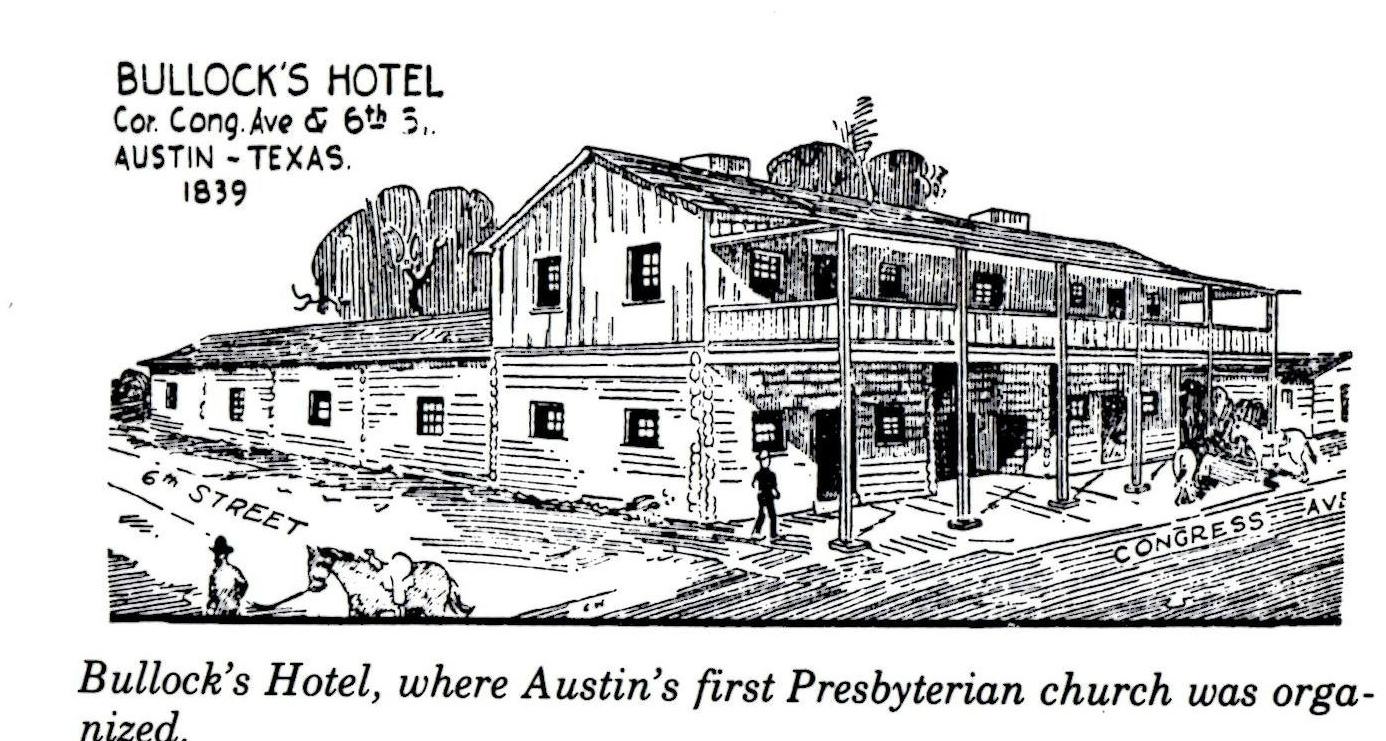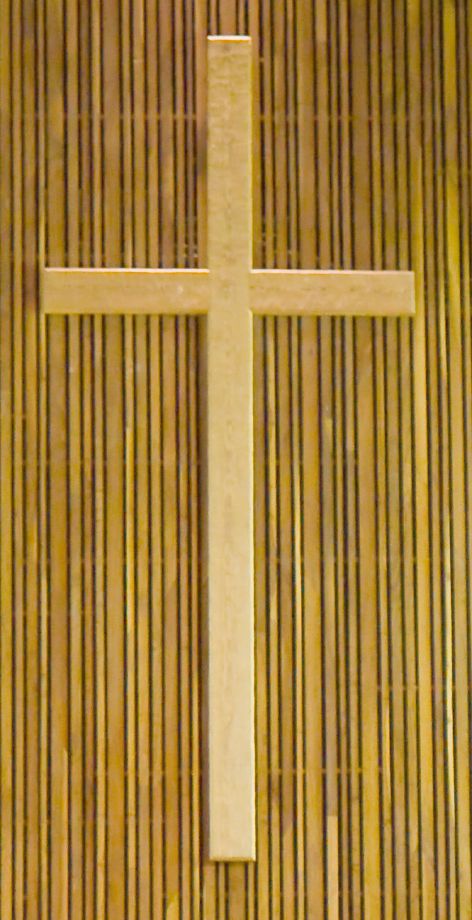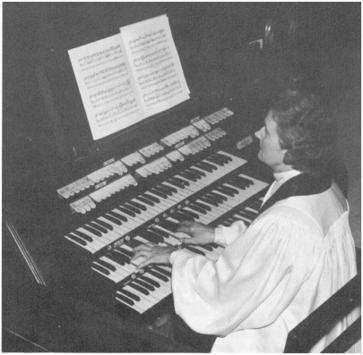History of CPC
“Seek the welfare of the city … and pray to the Lord on its behalf, for in its welfare you will find your welfare.”
— Jeremiah 29:7
Central Presbyterian Church has been seeking the welfare of Austin for over 185 years.

Austin was still a frontier town when the first Presbyterian church in the city was organized by Rev. William Youel Allen, with six members, on October 13, 1839, at Bullock’s Hotel on the corner of Congress Avenue and Sixth Street. Rev. Allen was Chaplain of the Republic of Texas House of Representatives. Just two and a half months later, on December 27, 1839, Austin was designated the capital city of the Republic of Texas. It wasn’t until 1845 that Texas was annexed as the 28th state.
Abner Cook, who went on to build many famous houses in Austin, including the Governor’s Mansion, built that first church, a small wooden building on the southeast corner of Lavaca and Bois d’Arc (now Seventh Street) in 1841. In 1844 a tornado destroyed the little Presbyterian church, and Presbyterian worship lapsed.
In 1848, Dr. Daniel Baker came to Austin and reorganized the Presbyterians, who had been meeting wherever they could find a room. Dr. Baker’s son, Rev. William Mumford Baker, was inspired by his father’s glowing description of Austin and its religious needs. After graduating from Princeton, he headed to Texas, and on May 26, 1850, organized the First Presbyterian Church of Austin with five members. Abner Cook donated land on the northeast corner of Lavaca and Bois d’Arc and built a frame church there. Rev. William M. Baker served the church from 1850 to 1865.
First Presbyterian grew steadily under Rev. Baker’s leadership until the Civil War erupted. When Abraham Lincoln was elected President in 1860, southern states began to secede from the Union, and Texas joined that secession movement on March 16, 1861. On April 12, 1861, the Civil War began.
The Central Texas Presbytery, of which First Presbyterian Church was a member, dissolved its connection with the General Assembly of the Presbyterian Church, U.S.A., and the Southern Assembly U.S. was formed in late 1861.
When the Civil War ended in 1865, bitter feelings about the conflict affected many aspects of southern life, including the church. In 1866, a pro-northern majority at First Presbyterian Church supported a resolution disclaiming all connection with the Central Texas Presbytery.
Some members who disagreed left First Presbyterian Church and maintained allegiance to the Central Texas Presbytery and the Southern Assembly. Recognized by the Central Texas Presbytery as a separate church following the 1866 division, the small, almost destitute congregation of Presbyterian Church (South) at first relied on visiting ministers. Unable to build a sanctuary, the congregation held services on an irregular basis.
As Presbyterian Church (South) struggled to remain viable, Dr. Abner Addison Porter (1869–1872) was a strong influence in forming the new church. On May 14, 1871, a contract was signed for the property that the church still occupies on the corner of Eighth and Brazos Streets. The cornerstone was laid on March 15, 1873. Support for the building program increased, and then the church, along with the rest of the country, had a major setback – the Financial Panic of 1873. Rev. Henry McDonald (1873–1874) encouraged increased giving, and construction resumed in 1874.
Although Dr. John S. Grasty served the church for only 18 months from 1874 to 1876, it was during his pastorate that enough money was raised to complete the sanctuary, and the new church building was dedicated in May 1875.
First identified as Presbyterian Church (South), the congregation has subsequently been known as Austin Presbyterian Church, Southern Presbyterian Church, Free Presbyterian Church (because pews were not for sale to families), First Southern Presbyterian Church, and since 1983, Central Presbyterian Church.
The Baptismal Font, A Special Gift

Young Dr. William J. Burt, a physician, arrived in Austin and became an elder of First Southern Presbyterian Church in 1875. His wife was deeply saddened to learn that she was unable to bear children. Hoping to comfort her, Dr. Burt saved part of the money from each of his house calls to be used to build her a grand home. He was approaching his goal of saving $10,000 when it was announced that the church was struggling to pay its debt. Dr. Burt and his wife decided to give their savings from that special fund to pay the church’s debt.
The owner of a monument business was so impressed by the Burts’ sacrifice that he gave the beautiful marble baptismal font that stands in the sanctuary today in their honor. The inscription reads, “Given by a friend.” The font is formed in three pieces of solid white marble that are held together only by gravity. It is one of the few remaining elements from the 1875 church building that has been in continuous use.
Growing the Church
In 1876, Dr. Richmond K. Smoot accepted a call to serve as pastor of First Southern Presbyterian Church. He remained until his death in 1905. During his tenure, the church grew from 72 to 282 members. Dr. Smoot was known as a persuasive orator, and he was elected Moderator of the General Assembly, U.S., in Atlanta, Georgia, in 1882.
Perhaps Dr. Smoot’s greatest accomplishment was his leadership in theological education in Austin. The School of Theology, the precursor of Austin Presbyterian Theological Seminary, was started in his house on Pecan Street (now Sixth Street) and in the basement of the church. When the seminary campus was established just north of the University of Texas campus, Dr. Smoot became chair of the Department of Church History and Polity.
Among the noteworthy members of First Southern Presbyterian Church at that time was William Sidney Porter (O. Henry), the master short story writer. He sang in the church choir with his bride Athol Estes and her mother. Porter and his wife were married by Dr. Smoot in the Smoot residence on Pecan Street in July 1887.
Dr. Josephus Johnson (1905–1908) was a congenial man known for his pastoral visits. Dr. Dougald N. McLaughlin (1908–1912) was an eloquent preacher who also served as Chaplain of the Texas Rangers in 1911. First Southern’s next pastor, Dr. William A. McLeod (1912–1915), who had been one of the students in the seminary that Rev. Smoot helped to found, went on to chair the seminary’s department of Systematic Theology.
Leading Through Challenging Times
Dr. William R. Minter (1915–1940) instituted a voluntary plan of pledging that provided financial stability. He also started the first Vacation Bible School and a Men’s Bible Class. During his tenure, a new education building adjacent and east of the north side of the church was completed, an impressive act of faith during the middle of the Great Depression.
Rev. Flynn Long (1940–1952) was an outspoken champion of unification between the northern and southern branches of the church, although that was not to take place for many more years. He performed many wartime marriages and worked to encourage people through times of stress and hardship during and after World War II.
Dr. John (Jack) William Lancaster (1953–1961) said that his primary concern was the survival of the church, which was trying to accommodate a growing congregation in a building that was inadequate to the task. During his tenure, the church wrestled with the decision of whether to move to the suburbs or remain downtown. While many downtown churches left, First Southern Presbyterian chose to stay. Plans for a new sanctuary were approved, and the cornerstone was laid on November 3, 1957. Church enrollment was 926.
In February 1965, largely through the leadership of First Southern Presbyterian Church Elder Harold Kilpatrick, thirty-nine state denominational leaders met at First Southern to sign a document creating the Texas Conference of Churches, which became the first conference in the world to embrace all Roman Catholics with Protestant and Orthodox communions.
Rev. Frank Walker (1965–1978) spearheaded new church programs for young adults and also for older people. He opened sessions of the Texas Senate with prayer, and became a well-known pastoral presence in downtown Austin. Rev. Walker was responsible for the project that resulted in the beautiful wooden cross that hangs in the chancel. The new sanctuary was completed and paid for during his tenure. And a new pipe organ was installed and dedicated on November 2, 1975.
The Wooden Cross

Photo © 2008 Red Letter Photos
The dominant visual element in the sanctuary is a 20-foot natural wooden cross, without finish, placed high on the north wall of the sanctuary behind the communion table. The cross, which was installed in 1967, has an international and ecumenical history.
Guenther Oswald was a German national, who as a soldier in World War II was wounded five times before being captured and sent to a prisoner of war camp in Colorado. Oswald was grateful for the humane treatment he received at the hands of the United States. He returned to Germany after his release and learned to be a carpenter and cabinetmaker. He then moved to Austin because he had relatives in the area. Oswald crafted the cross as an expression of his thanks to the United States. He set up his own business and worked in Austin for the rest of his life.
The wood for the cross is repurposed material. St. Mary’s Catholic Academy, once located on the city block south of the church where the Omni Hotel now stands, was taken down after its useful life. The timbers from the school’s structure were salvaged, and two of its beams were used by Oswald to hand hew the cross.
The Sanctuary
The sanctuary building was designed by award-winning, 1950’s Austin architectural firm Fehr and Granger. It’s designed in the international architectural style, which embodies clear visual expression of the building structure, separation of the enclosing walls from the building frame, an exterior envelope of solid stone masonry inside to out that visually elevates the roof structure from the exterior walls, the absence of architectural ornament or embellishment, and the use of indigenous, simple building materials.
In keeping with Reformed liturgy, the sanctuary includes a lectern for reading scripture and a pulpit for proclaiming the Gospel. The two sacraments, baptism and communion, are evidenced and serviced by the historic, white marble baptismal font and a simple wood table on the chancel. The center aisle provides for processionals and orientation toward the worship leaders. The stained glass windows in the exterior Austin limestone masonry walls are an artist’s expression in color and light of the Father, Son, and Holy Spirit.
Organ pipes are behind the vertical wood screen on the north wall. The high ceiling and hard interior surfaces create a resonating space that is excellent for music.
The Pipe Organ
Music has always been an integral part of church life at Central Presbyterian. The current pipe organ, completed and dedicated in 1975, is a four-division, 60-rank pipe organ with more than 3,000 pipes. It was constructed and assembled from several prior instruments by master organ builder Otto Jurgen Hoffman, a craftsman born in Kyle, Texas, who was an influential proponent of the Organ Reform style of organ building.
The organ console behind the pulpit is comprised of three manuals and a pedalboard, corresponding to the four divisions of the organ (great, choir, swell, and pedal). The organ chamber containing the pipes is behind the elevated cross and the walnut screen on the sanctuary’s north wall.
The organ is used not only for worship services but also for performances for the church and the community.
A New Era and a New Name
Finally, after years of discussion, the northern and southern denominations of the Presbyterian Church voted to approve unification in 1983. And the congregation voted to change its name to Central Presbyterian Church.
Dr. Dean K. Thompson (1979–1984) brought innovation to Central Presbyterian, including the weekly Thursday noon concerts. And Central called its first female associate pastor, Rev. Laura Mendenhall, who served from 1983 to 1986, providing leadership in Christian education and programming for all age groups. She became Dr. Mendenhall in 1997 and has served the Presbyterian Church in many leadership capacities. She was the first female president of Columbia Theological Seminary. Also during Rev. Thompson’s tenure, Rev. Laura Mendenhall’s husband, Rev. Charles Mendenhall, was named director of the Central City Counseling Center, which later became the Samaritan Counseling Center. As the program expanded, other Austin Presbyterian churches became involved.
When Rev. Richard A. Thompson (no relation to the previous Rev. Thompson) came to Austin (1986–1995), he saw that the church was surrounded by tall buildings, and thought that Central should heighten its profile in the community. He initiated a capital improvement program, community outreach programs, and banners over Eighth Street to highlight the worship services and the concert series. In 1989, the church was recognized by the Texas Historical Commission as a historical site, and a marker was placed in the courtyard. Rev. Thompson had experience in ecumenical broadcasting, which he put to use developing a public affairs series, “Austin Faith Dialogue,” in cooperation with CBS affiliate KTBC-TV and Austin Metropolitan Ministries.
Rev. Greg McDonell was called as pastor of Central Presbyterian in January 1997. Under his leadership, the church became well known for having a welcoming spirit and a special heart for mission. He assembled a long-range planning team of church members to study the needs of the city and the church in order to meet the changing needs of Austin. The team developed a long-range plan to engage members in serving the church, and wrote mission and vision statements, which were adopted by the Session on August 14, 2004.
Our Mission
Deliberately diverse and fully inclusive, Central Presbyterian Church in downtown Austin is a community of Christian faith where each person is welcomed as a unique child of God.
Our Vision
Ministering to the needs of God’s people is at the heart of this congregation. Individually and together, we respond to God’s love, grace and justice in Jesus Christ. Guided by scripture and our Reformed tradition, we actively work toward peace, justice, and spiritual growth. Through worship, music, fellowship, Christian education, and service to others, we continue to glorify God and proclaim the good news of Jesus Christ.
Serving in the Heart of the City
In February 2010, Rev. Joseph Moore joined the staff, and he and Rev. McDonell became Co-Pastors of Central Presbyterian, serving together in this capacity until Rev. McDonell’s retirement in October 2012, at which time, Rev. Moore became Pastor/Head of Staff. In the years since, the church has successfully expanded the staff to meet the needs of our growing ministry, including an Associate Pastor, a full-time Director of Christian Education, and an Office Manager.
For members of Central Presbyterian, “seek the welfare of the city” means having a deep and ongoing commitment to mission. Under the leadership of our Mission Team and Co-Pastors, our Session passed a resolution calling for us to dedicate at least 10 percent of pledges received to mission.
In 2012, with the support of the Co-Pastors, Kim Rogers, who was then an Austin Presbyterian Theological Seminary student serving our church as an intern, started The Central Mission, an outreach program to serve the homeless and low-income people of Austin. Every Thursday morning, volunteers and staff welcome those who need help to our fellowship hall, providing them with breakfast, fellowship, a sense of community, financial assistance, toiletries, clothing, and other necessities.
Under the leadership of the Rev. Katheryn Barlow-Williams and the Rev. Carolina Trevino the church continues to “Seek the welfare of the city … and pray to the Lord on its behalf.”
Some of the information for this brief history was gleaned from the book The Roots of Central Presbyterian Church by Bo Byers.
Text of Historical Marker

Placed at Central Presbyterian Church, Austin, Texas in 1988 by the Texas Historical Commission
Central Presbyterian Church
This congregation traces its roots to October 13, 1839, when Austin’s first Presbyterian worship service was held at Bullock’s hotel. Present that day was builder Abner Cook, elder in the first Presbyterian church organized in Austin. He helped acquire this property for the Presbyterian Church (South) following a post-Civil War split in the church. A sanctuary was completed on the site in 1874.
This congregation was known in later years as Southern Presbyterian Church, the Free Presbyterian Church, First Southern Presbyterian Church, and Central Presbyterian Church. It has counted among its members many individuals important in the life of the denomination and the city of Austin, including Gov. Francis R. Lubbock; William Sidney Porter (O. Henry); A. N. and Jane Y. McCallum; Dr. George Clark and Rebecca Kilgore Stuart Red; and U. S. Attorney General Thomas Watt Gregory. The Rev. Richmond Kelley Smoot played an important role in the national denomination and in the development of the Austin Presbyterian Theological Seminary.
This congregation was instrumental in organizing five Presbyterian churches in Austin. It continues a program of ministry, outreach, and cultural events.

